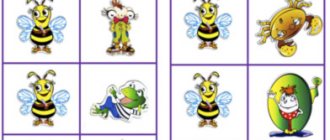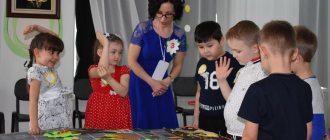All children in the world are united by a love of games.
Play is a natural need for a child, since it is in the form of play that children learn about the world, understand how it works, and consciously comprehend the experience gained.
Play is important not just as a source of joy and good mood, it develops the brain, imagination, creativity, vocabulary, social skills, the ability to learn and perceive more complex information.
How do 6-7 year old children develop?
At this age, the baby’s thinking abilities enter a new, better stage of development.
By age 6, most children:
- master reading, writing, counting to 20;
- understand the simplest time intervals;
- focus longer on one solution to one logical problem;
- their reasoning becomes more meaningful;
- understand information better by listening.
What games are useful at this age?
For a preschooler, different forms of games will be useful.
Psychologists recommend involving children in the following game formats:
- child-initiated play;
- play initiated by an adult;
- a traditional game when both a child and an adult can take the initiative.
From the point of view of benefits, the most significant games are those offered by adults, since in this case the child finds himself in a learning situation, gets acquainted with new words, concepts and can make this situation manageable.
As for choosing a specific game format, it all depends on the situation. For the street, outdoor games are selected that contain an element of sports. At home, you can play board games or role-playing games, or assemble a construction set.
1. Outdoor games develop coordination, strength, endurance, and reaction speed. At the age of 6-7 years, the game lasts about half an hour.
2. Board games help brighten up your leisure time when the weather is bad outside. With the help of cubes, puzzles, figures, cards, the child improves his skills - logic, spatial thinking, social interaction, speech, concentration, will.
There are a huge number of board games - walkers, puzzles, cubes, mosaics, construction sets, flashcards, strategies.
3. Educational games - in this case we are talking about the targeted development of a specific skill or ability, for example, speech, gross motor skills, intelligence, imagination.
The use of such games prepares fertile ground for the further development of the child’s creative abilities and talents. The training program is structured from simple to complex, but the conditions of each task should be slightly ahead of the child’s developmental level.
Educational games in kindergarten: functions of games in the educational process
Attending kindergarten is an important stage in the life of any child. It is in the process of kindergarten education that the child gains his first experience of communicating with elders and peers, learns new models of behavior, and gets used to organizing the day. One of the main functions of any preschool institution is the education and development of the child. Every child learns about the world around him through games and toys.
A game is a form of activity and interaction between participants in the process, the main motive of which is to model a certain situation in a simplified form and test it in practice. Play for a child begins at an early age with learning about the world around him by studying surrounding objects and comparing them. The main elements of play for a child are both toys and objects from the surrounding world. The first year of a child’s life is characterized by the most intensive development and acquisition of basic skills, which will only improve in the future. With the acquisition of new skills and experience, the games that interest the child become more complex. Educational games in kindergarten contribute to the development of perception, logical, creative thinking, memory, attention, and imagination. Another important characteristic of educational games in dow is the socialization of the child, his involvement in team play, learning to evaluate and distribute roles.
Unlike the educational games that children enjoy at home, educational games in kindergarten are completely controlled by the teacher. Depending on the type of preschool institution, educational games in a preschool can be aimed at correcting certain conditions (physical development, mental development, speech therapy defects) and developing creativity.
Educational games in kindergarten are offered to children taking into account the age, level of development, abilities, and capabilities of the children. It should be noted that games in the younger group differ significantly from the games offered to children in older groups of kindergartens. What are these differences?
Games 30. Plant
First of all, you need to make a plant - a tree, a flower - from any available materials. Then the child composes a fairy tale about him. The main thing is that in the story the child describes in detail how the plant feels - is it comfortable or is something bothering it.
Through these metaphors, an adult can understand what is bothering the child. If there is a cause for concern, ask your child what you can do to help the plant - build a fence, call a fairy, plant other trees. This way the baby will use the example of a fairy tale to cope with his anxieties.
Games 31. Face games
In children who have suffered some unpleasant events in life, a frozen mask may appear on their face and emotions disappear. You can motivate your child in several ways - invite him to play tricks, make funny faces with him, or organize a home theater.
Games 32. Simple holidays
Allow your baby to feel the holiday in your life as often as possible. Try to turn every simple event into something bright and unusual. For example, the festival of making the bed, washing, the festival of lunch. Be sure to record any of your child’s achievements, write them down or draw them - this motivates and builds confidence in yourself and your abilities.
Games 33. Color therapy
If your child often returns to unpleasant events in the past, focus his attention on the current day, for example, come up with a specific color for each day of the week and try to stick to it. For example, let Monday be blue - pick up such clothes, look for blue objects around.
Games 34. Schedule
To stabilize a child’s condition after a stressful situation, it is necessary to structure his daily routine, draw up a schedule, and decorate it. The kid must monitor its implementation. On the one hand, it teaches discipline, and on the other, it distracts from unpleasant thoughts.
Advice! Anxious children prone to stress intuitively choose outdoor games where they need to jump. This helps relieve tension and feel supported. Create an area for your child where he can jump safely and happily.
Conflict situations sometimes occur between children, and here play becomes critically important, since with its help the child relieves stress and relaxes . Of course, games should be appropriate for the child’s age and development, be diverse and useful. This is what we will talk about in our material.
Where to find time to play with your child
This question is asked by many parents, since modern moms and dads are busy people who have a lot of household responsibilities, work, of course, and a natural desire to take time for themselves and relax. Due to the fact that there is not enough time to spend with the baby, parents often worry and worry. Psychologists assure that you can find time to communicate with your child if you follow simple tips.
Tip 1 – play with your child and mind your own business at the same time.
Games that do not require special training or additional items can be played in the kitchen, bathroom, or on the street. If you don’t feel like playing, involve your child in homework, do something together, for example, make pizza, or just let your child help you.
The main thing is to talk to the child more, explain, praise and support.
Tip 2 – use any free minute.
Transport, queues, the road to somewhere - this time can be used profitably. Tell your child about natural phenomena, make riddles, compose fairy tales, play counting and words.
Tip 3 – games and activities should become a habit.
Of course, we are not talking about classes for an hour or two. Make it a rule to work with your child every day for 15-20 minutes; this will be quite enough for a child aged 6-7 years. For example, read a book to your child before bed.
Tip 4 – try to create a nurturing environment at home.
Use posters, manuals, cards, magnetic games. The more educational objects there are around a child, the faster he will remember information. Please note that developmental aids should be bright and colorful.
Tip 5 – find company for your child.
If this is the case and you cannot play with your baby, try to find children for him with whom he can spend his time.
Educational games for children of the senior group of kindergarten card file (senior group) on the topic
Educational games for children in the senior group of kindergarten
Games aimed at developing logic in senior preschoolers
Game "Find options".
Goal: to develop logical thinking and intelligence.
Game material and visual aids: cards with the image of 6 circles.
Description: give the child a card with a picture of 6 circles, ask them to paint them in such a way that there are equal numbers of filled and unshaded figures. Then view and calculate all painting options. You can also hold a competition to see who can find the largest number of solutions.
Game "Wizards".
Goal: to develop thinking and imagination. Game material and visual aids: sheets depicting geometric shapes.
Description: Children are given sheets depicting geometric shapes. Based on them, it is necessary to create a more complex drawing. For example: rectangle - window, aquarium, house; circle - ball, snowman, wheel, apple. The game can be played in the form of a competition: who can come up with and draw the most pictures using one geometric figure. The winner is awarded a symbolic prize.
Game "Collect a flower".
Goal: to develop thinking, the ability to analyze and synthesize.
Game material and visual aids: cards depicting objects related to the same concept (clothing, animals, insects, etc.).
Description: each child is given a round card - the middle of the future flower (one - a dress, the second - an elephant, the third - a bee, etc.). Then the game is played in the same way as in lotto: the presenter distributes cards with images of various objects. Each participant must assemble a flower from cards, the petals of which depict objects related to the same concept (clothing, insect, etc.).
Game "Logical endings".
Goal: to develop logical thinking, imagination, ability to analyze.
Description: children are asked to complete the sentences:
• Lemon is sour, and sugar... (sweet).
• You walk with your feet, but throw... (with your hands).
• If the table is higher than the chair, then the chair... (below the table).
• If two are more than one, then one... (less than two).
• If Sasha left the house before Seryozha, then Seryozha... (left later than Sasha).
• If the river is deeper than a stream, then the stream... (smaller than a river).
• If the sister is older than the brother, then the brother... (younger than the sister).
• If the right hand is on the right, then the left hand... (on the left).
• Boys grow up to become men, and girls... (women).
Game "Ornament".
Goal: to develop logical thinking and the ability to analyze.
Game material and visual aids: 4-5 groups of geometric shapes (triangles, squares, rectangles, etc.), cut out of colored cardboard (figures of one group are divided into subgroups differing in color and size).
Description: invite the child to consider how you can create ornaments from geometric shapes on a playing field (sheet of cardboard). Then lay out the ornament (according to a model, according to your own plan, under dictation), using concepts such as “right”, “left”, “above”, “below”.
Game "Helpful - Harmful."
Goal: to develop thinking, imagination, ability to analyze.
Description: consider any object or phenomenon, noting its positive and negative sides, for example: if it rains, this is good, because plants drink water and grow better, but if it rains for too long, this is bad, because plant roots can rot from excess moisture.
Game “What did I wish for?”
Goal: develop thinking.
Game material and visual aids: 10 circles of different colors and sizes.
Description: lay out 10 circles of different colors and sizes in front of the child, invite the child to show the circle that the teacher ordered. Explain the rules of the game: when guessing, you can ask questions, only with the words more or less. For example:
- Is this circle bigger than red? (Yes.)
- Is it bigger than blue? (Yes.)
- More yellow? (No.)
- Is this a green circle? (Yes.)
Game "Plant Flowers".
Goal: develop thinking.
Game material and visual aids: 40 cards with images of flowers with different petal shapes, sizes, and core colors.
Description: invite the child to “plant flowers in the flowerbeds”: in a round flowerbed all flowers with round petals, in a square flowerbed - flowers with a yellow core, in a rectangular flowerbed - all large flowers.
Questions: what flowers were left without a flowerbed? Which ones can grow in two or three flower beds?
Game "Group by characteristics."
Goal: to consolidate the ability to use generalizing concepts, expressing them in words.
Game material and visual aids: cards with images of objects (orange, carrot, tomato, apple, chicken, sun).
Description: place cards in front of the child with images of different objects that can be combined into several groups according to some characteristic. For example: orange, carrot, tomato, apple - food; orange, apple - fruits; carrots, tomatoes - vegetables; orange, tomato, apple, ball, sun - round; orange, carrots - orange; sun, chicken - yellow.
Game "Remember faster."
Goal: develop logical thinking.
Description: invite the child to quickly remember and name three round objects, three wooden objects, four pets, etc.
Game "Everything that flies."
Goal: develop logical thinking.
Game material and visual aids: several pictures with various objects.
Description: invite the child to select the proposed pictures based on the named characteristic. For example: everything is round or everything is warm, or everything is animate that can fly, etc.
Game "What is it made of"
Goals: develop logical thinking; consolidate the ability to determine what material an object is made of.
Description: the teacher names some material, and the child must list everything that can be made from it. For example: tree. (You can use it to make paper, boards, furniture, toys, dishes, pencils.)
Game “What Happens...”
Goal: develop logical thinking.
Description: invite the child to take turns asking each other questions in the following order:
- What is big? (House, car, joy, fear, etc.)
- What is narrow? (Path, mite, face, street, etc.)
— What happens to be low (high)?
— What is red (white, yellow)?
— What is long (short)?
Intelligence of a child aged 6-7 years
At this age, children have already formed personalities and have their own views on the world around them and what is happening in it. The child understands his position both in the children's team and among adults, and accordingly builds a line of behavior and forms a certain attitude towards the people who surround him.
The level of emotional development in children 6-7 years old is also quite high. They show sympathy , empathize, feel the mood of other people, and offer help.
- We are talking about children who are almost first graders, they can control their mood, follow the instructions and requests of adults, and take part in group and individual activities.
Advice! Since children 6-7 years old easily navigate circumstances, parents can give their child the basics of personal safety and teach them to find a way out of difficult situations.
2. At 6-7 years old, children show an active interest in new knowledge, since at this age the memory capacity increases, the child’s attention becomes more concentrated, and the vocabulary expands (up to 6 thousand words).
3. Parents need to continue classes on the development of children’s speech, familiarize children with the structure of language, in addition, develop fine motor skills, logic, and the ability to systematize objects by characteristics.





